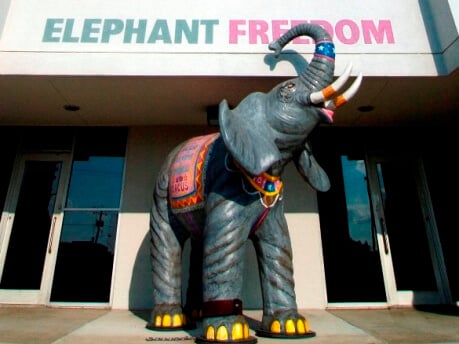In the face of growing public condemnation, Ringling Bros. and Barnum & Bailey Circus has finally conceded: It’s eliminating elephant acts this May instead of next year, bringing the lame and ailing animals some measure of relief from their days on end chained in stifling, reeking boxcars. But don’t pop the champagne corks just yet.
Despite Ringling’s spin on what comes next, the circus’s Florida breeding compound—where the elephants will be sent—has its own fundamental flaws. At the grandiosely named Center for Elephant Conservation (CEC), elephants are still chained on a daily basis, forced to breed (although no elephant born there will ever set foot in the wild), deprived of opportunities to interact and socialize normally, and continue to live in fear of being whacked with a bullhook or shocked with an electric prod.
According to the sworn testimony of the general manager of the CEC, some elephants at the facility are routinely chained on concrete floors for up to 23 hours a day. They are typically chained by two legs—one hind leg and one foreleg—which prevents them from taking more than a step or two in any direction. These keenly social animals, who need contact and interaction with other elephants, have little opportunity to engage in the activities that give their lives meaning. The general manager also testified that pregnant elephants at the CEC are chained by two or three legs for at least two weeks prior to their due dates.
During a court-ordered inspection of the CEC, an elephant-care specialist observed that elephants spent so much time chained that they had worn grooves into the concrete floor.
Chaining on hard surfaces makes elephants prone to arthritis, infection and psychological stress and can ultimately lead to premature death. Chained elephants often sway back and forth like manic metronomes and repeatedly shift their weight from one foot to another in a desperate attempt to cope.
In another chilling revelation, the U.S. Department of Agriculture found that the CEC is awash in tuberculosis (TB), calling it “[t]he facility with the highest incidence of TB in their elephants,” and as a result, the CEC has been the subject of a series of government-mandated quarantines. TB is highly transmissible from elephants to humans, even without direct contact. Just last month, two Ringling workers were barred from performing in Indianapolis after testing positive for possible TB. Seven employees at the Oregon Zoo contracted TB from three elephants in their care in 2013, according to the U.S. Centers for Disease Control and Prevention.
The CEC’s goal is to try to ensure a steady supply of captive elephants for circuses and now, more recently, zoos. CEC veterinarian Dr. Dennis Schmitt admitted under oath that the CEC has no intention of introducing elephants into the wild. And Ringling recklessly breeds elephants years before they are mature. Wild Asian elephants don’t normally have their first calves until they are 18 to 20 years old. But Shirley, for example, gave birth to her first calf at the CEC when she was just 8 years old, followed by two more at ages 11 and 17. At least four baby elephants born at the CEC have died.
Elephants who have endured years of suffering while earning Ringling millions of dollars deserve better—including rehabilitation for both their physical and their psychological troubles. This will not happen at the CEC. It could happen at the two accredited elephant sanctuaries in the U.S., the Performing Animal Welfare Society in California and The Elephant Sanctuary in Tennessee. That’s where these elephants belong.





